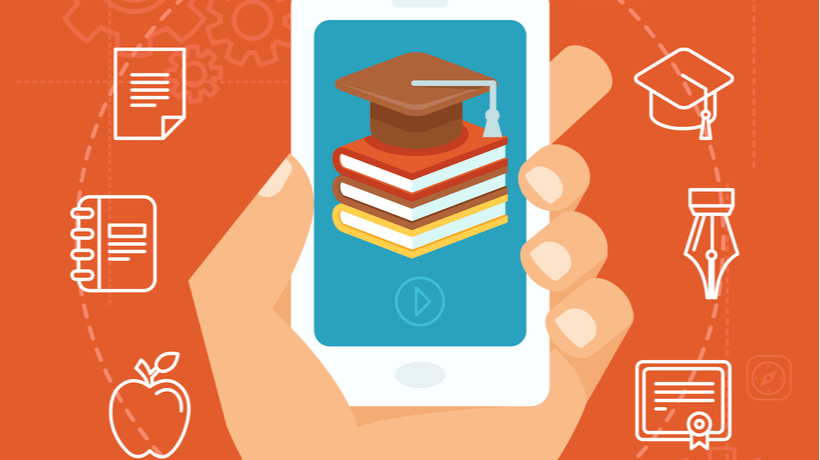The Mobile Learning Vision
With ultra portable devices, technology is at last providing relevant and engaging new ways to support learners more powerfully and more closely than ever before. So what does it all mean and what’s so great about it?
Sounds good but where do you start? Well, it’s a big area, but it doesn’t have to be daunting. Let’s get practical for a while and think about how you might want to mobile-enable your own organization? All the solution elements are now in place and proven. To make it manageable, I’ve broken it down into a five-step approach, which you might find useful:
OK, imagine a world where you have immediate access to the latest versions of all the company training courses you’ve ever done, access to short nuggets of training to remind you of what you’ve learnt and might be in danger of forgetting, or just-in-time training and reference materials for those tough and very specific tasks that normal training can never cover. Add to this job aids and procedures to help you perform the task at hand, news updates and a full library of other multimedia digital resources.
Now imagine that everything is filtered for its relevance to you based perhaps on your job role or maybe the course you are signed up to, and is then delivered to your preferred device, be it laptop, tablet or smartphone. Imagine being able to search it, consume it offline and have your learning experiences automatically tracked…. Now imagine all that being managed and updated from a single central platform, which is also looking after many thousands of your colleagues.
If you can imagine all that, you can start to see why so many people see mobile learning as the undoubted way of the future. The exciting thing is that all of this is now available as part of proven, end-to-end solutions.
With mobile devices leaping forwards in terms of functionality and capacity, and with network bandwidth and wifi options dramatically increasing, the technology is suddenly all available. Some suppliers are struggling; others are exploring their way forward and the best ones are already there.
So, what is the overall solution? Think holistic. Think fully integrated. It has to cover the start-to-finish, end-to-end, soup-to-nuts system. Why? Because nothing less is good enough. Users demand good quality content, attractive user interfaces and extreme ease of use. Training organizations demand a comprehensive mobile publishing platform with ease of operation, tailored content, massive amounts of feedback, completion and assessment data, and most importantly, the assurance that the money and effort that they are putting into their training is actually improving staff performance and efficiency. Firstly let’s look at a couple of possible scenarios to see what’s possible and where the opportunities for delivering effective learning and employee performance support are.
2 Scenarios of Effective Learning and Employee Performance Support
Scenario 1 – Field Sales
Acme Pharmaceuticals send their salesmen out to visit doctors in health centers and hospitals nationally. New salesmen are put through an intensive four-week residential training course focused on the sales process, and the benefits and features of their range of medical products. They then work from home and cover a lot of miles to reach customers all over the country. Multiple 45-minute eLearning courses are distributed to them from the company’s LMS, they access them from home, and results are SCORM tracked. In addition the salesman are issued with tablets and have downloaded an Acme branded App provided by the company. The formal eLearning is also downloaded into the App for optional offline consumption when they are traveling, and again their activity is SCORM tracked and passed back to the LMS when they next connect. So far, all fairly normal.
But the company also takes a leap forward and stores multiple other digital assets as well as eLearning on its single central LMS, such as product demonstration videos, audio podcasts covering selling skills ‘hints and tips’, price lists and product demo aids such as customer presentation PowerPoint decks, competitor analyses and PDF product fact sheets and competitor ‘battle cards’. They add to the rich set of training and support resources with simple job aids in the form of time-sheets and expense claim forms, customer order forms and price calculator tools. The central system administrator loads up the various assets and targets them to specific user groups so they only ever get to see what’s relevant to them.
Our pharmaceutical company needs to keep its staff totally up to date, so it adds company news feeds to the App, and links to its social networking platform. Special offers, promotions, product news and topical discussion ideas are all distributed to support the team in their sales effort. Push notifications relating to newly available and updated items bring these to everyone’s attention reducing reliance on periodic emails.
Get the picture? The LMS has become a powerful and flexible central support hub meeting employee’s multiple business needs and delivering a whole range of support materials out to them for offline consumption wherever they are.
Scenario 2 - Engineering
Sister division Acme Engineering decides on a different route. They employ so many field maintenance engineers that they don’t want to provide employees with company devices at all. Instead they want to support a BYOD initiative and enable staff to use their own smart phones and tablets. So they provide a range of company branded Apps, which support Android, iOS and Windows8 phones and tablets. All of their custom authored content is optimized for phones and tablets by using responsive HTML5 publishing. Modules are kept deliberately short, under five minutes’ duration. Each consists of a set of diagrams of a mechanical device with a specific fault, a video of an experienced engineer rectifying the fault with a voiceover talking through the process. The responsive HTML5 content lays out beautifully to fit the screen size and orientation of the phone or tablet device used, delivering a clear and quality user experience. As well as tracking the usage of the mini-courses, quick exit surveys are incorporated to gain engineer feedback, which can be shared using a star rating system within the catalogue of the common corporate LMS.
They go a step further and enable their engineers to upload videos of themselves tackling specific problems. This user-generated content (UGC) is moderated centrally, and then shared as learning resources and are subject to the same user community ranking. Suddenly they have tapped into the combined knowledge of their whole team of engineers to create up-to-date training resources and then use the community to filter and rank that content.
I’m fascinated by the opportunities presented by this new mobile approach – as you’ve probably guessed my own company is doing all the above with the authoring tools, deployment platform and Apps that are necessary for the integrated end-to-end approach I believe is crucial. But the really exciting thing about this area is not the specific solutions that I can identify; it is the inherent flexibility of the end-to-end solution and the many varied applications that my clients are already finding for it. These range from Universities reaching out to support national and overseas students, to specialist training companies supporting their learner communities, through to enormous blue chip corporates incorporating our gamification options and providing training and support to thousands of employees in multiple geographies.
5 Steps To Go Mobile
Sounds good but where do you start? Well, it’s a big area, but it doesn’t have to be daunting. Let’s get practical for a while and think about how you might want to mobile-enable your own organization? All the solution elements are now in place and proven. To make it manageable, I’ve broken it down into a five-step approach, which you might find useful:
- Understand what you want to deliver to your community and why
Think about the curriculum design – does a mobile delivery approach support your overall strategic objectives and if so which topics will still best be covered face-to-face, which via distance learning, which via just-in-time training and which through performance support tools – maybe some will need them all. There are plenty of educational consultants out there who can help, but bear in mind this is a relatively new field, so pick someone who has already got real experience. Curricula design here is all about planning what the best learning formats are for different topic areas and learner groups. Mobile content is consumed in a different way to traditional eLearning, so you will probably want to roll with the flow here and provide content in a form that meets the user’s preferences. In my experience of the mobile world, this means shorter, more focused content, delivered at more regular intervals – content that is designed to augment and add value to your existing training programs. - Pick the technology solution that you need
Of course you can design and build it from scratch yourself, but it’s much more sensible to pick an off-the-shelf technical solution. You need one that works, is customizable, supports system’s integration and is flexible enough to handle your own specific requirements. Again, as this is a new area make sure you pick a proven solution, which has already been deployed in some major organizations. As a minimum you will need a central mobile learning platform to centrally manage the publishing and targeted distribution of your multiple types of content to mobile devices. Think about scalability and ensure your solution can handle lots of additional content and user numbers into the future. You will also need Apps for the mobile devices themselves to enable users to locally store, search and consume content, collecting SCORM and user analytics to pass back to the mobile learning platform. Usability will be a key thing, the Apps and the content have to look and feel great and be really easy to use, otherwise users will simply avoid using them. - Create your content in the right format
Here we’re really talking about HTML5, old-fashioned Flash just won’t cut it. Select an experienced HTML5 supplier who knows the technology and is also educationally good at what they do. My own Company also supplies HTML5 authoring tools as an alternative to using its content creation services, the principle being that choice is always a positive thing. But whichever way you go, remember that however seamless the technical solution, the quality of the content is what it is all about.If you want to distribute to phones use responsive HTML5 and keep the content short and easy to digest. Converting and refactoring your old content to run on mobiles is entirely feasible, but the cost will vary on the effort required. Conversion is usually quicker and cheaper than reconstruction – but not always, so spend a little time talking this through with your suppliers, they should be able to come up with a few different alternatives for you to choose from. - Pick a good mobile ready hosting and delivery platform
You will need a mobile ready learning management system (LMS) or if you already have a corporate one and don’t want another just for mobile, then go for a mobile learning platform which specifically supports a rich variety of digital learning asset types and comes with Apps for all major mobile operating systems, in other words that supports BYOD (you may not want BYOD today but you probably will in the future). It should be possible to integrate data feeds into your main corporate LMS if required – so ensure the system has integration APIs. System reliability, scalability, security and ease of operation are all factors, which a trusted supplier can help you with. - Don’t forget to think Apps!
This is a big part of what your users will see, so the experience has got to be fluid, slick and dare I say it, beautiful. Rich functionality is important and by this I mean local catalogue, search, offline consumption, SCORM tracking, data analytics, push notifications, access to the device’s photo and video libraries for user generated content and so on.My preferred approach is to use native Apps (ie Apps created specifically to run on the target mobile operating system such as iOS and Android), rather than less capable, generic Web Apps. The user experience and performance is so much better and they open up the full capabilities inherent in the device – very important for more advanced functionality.
No one would have thought even a year ago that complete, off-the-shelf, end-to-end solutions would be available. But they are, and they have driven the cost and complexity of these advanced systems right down. With full user analytics to complete the loop, these mobile learning solutions can be installed and rolled out quickly and cost effectively. If you pick a good, scalable solution from a leading supplier, then you will have the option to start small and measure the results with your users. Then you can refine and extend the solution to other parts of your operation as you wish, providing an easy route into this new world of powerful learning support, delivering dramatically increased employee and learner effectiveness. And in case you’re in any doubt, Acme companies are examples only and do not represent real organizations; any similarity to any real clients that I have recently been working with is entirely accidental!









